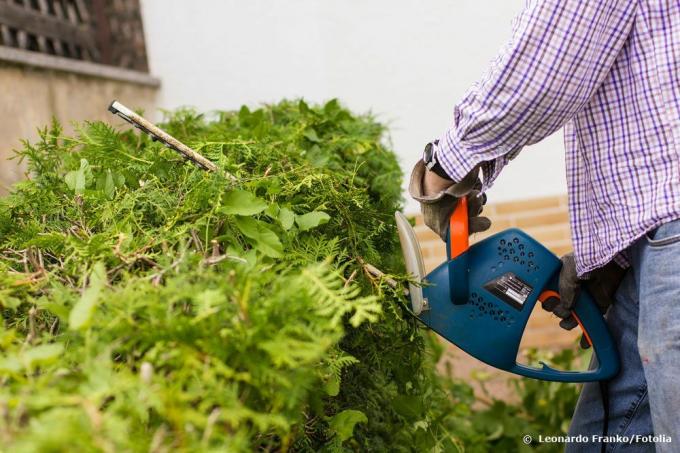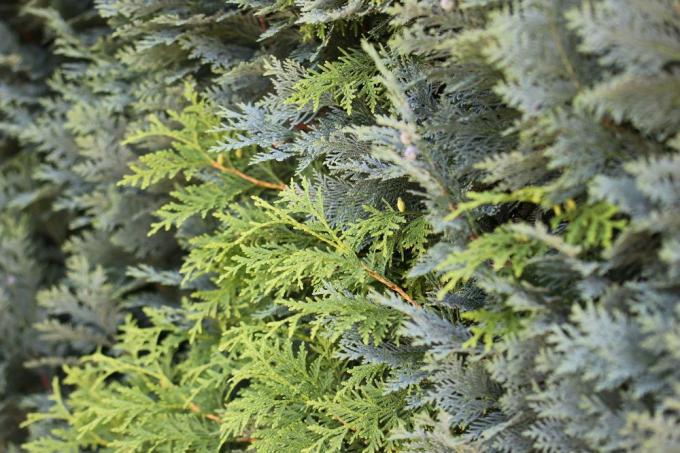
table of contents
- Radically prune thuja hedge
- Good reasons for radical cuts
- Cutting thuja hedge radically: instructions
- Time and frequency
- Methods
- Complete cut
- Complete cut, spread over several years
- Limitation in height
- Cut back the thuja regularly
The occidental tree of life, also called simply Thuja after its botanical name Thuja occidentalis, is a sturdy and fast-growing conifer, which as a solitary can be hundreds of years old and dozens of meters high can. Even a thuja hedge can easily reach a height of ten meters within a few years and can be up to three meters wide - no wonder that so many gardeners only help themselves with a radical cut White.
Radically prune thuja hedge
Thuja are perfect trees for use as a privacy hedge: They are very adaptable, can cope with almost any location and grow very quickly and tight. Depending on the type and variety, the conifers develop between 30 and 50 centimeters of new shoots per year and thus reach considerable heights within a few years. Even if the species generally has a rather slender habit, Thujas still continuously grow in width. For this reason, regular pruning is recommended right from the start, otherwise the hedge will quickly grow over your head - and cutting the trees radically is absolutely not recommended.
Inside, thuyas are bald and Brown, because the thick branches and twigs there are no longer green due to the lack of sunlight. Like so many coniferous plants, trees of life no longer sprout, or only sprout with great difficulty, once they have cut into the old wood. Therefore, never cut into the brown inside, but still leave soft, green shoots! Many gardeners have regretted a radical cut because the once lush, green and dense hedge remained bare and unsightly. In some cases it sprouted again, but experience shows that it takes several years before the bald spots can no longer be seen.
Good reasons for radical cuts
Even if radical pruning of the thuja hedge is not such a good idea from a horticultural point of view, there are good reasons to do it anyway. Be it because it has become significantly higher and / or wider than allowed (and the neighbors are complaining because it is several meters high Woods rob them of the sunlight) or because the plants themselves suffer from a disease and can only be saved by vigorous pruning can. Fungal infections, for example, occur more frequently and often require heavy trimming deep into the still healthy wood. Therefore, with this article we provide you with instructions on how you can still save your thuja hedge.
tip: If your thuja hedge has not been in place for more than four or five years, you can try to save it by transplanting it. This procedure is recommended if the legal distance to the property line has become too small or if the neighbors are complaining.
Cutting thuja hedge radically: instructions
If, after weighing all the reasons, you decide to cut back radically, you always have to die include the thuja - the probability that the arborvitae will sprout from the brown wood is right small amount. The tips and methods outlined in the following section will increase the chance that your hedge will stay beautiful - and significantly smaller.
Time and frequency
To ensure that the drastic pruning is crowned with success and that the hedge is quickly driven out again, pruning shears and pruning saw must be used at the right time. If you prune the trees at the wrong time of year, there is a high probability that no further new shoots will emerge. Around the sleeping eyes - which actually every wood has and which are there for that - a greater loss of mass to balance - to wake up the thuja hedge right before spring sprouts by the end of February cut back.
Spring pruning stimulates growth
On the one hand, there is a strong pruning from the beginning of March no longer permitted by law, because songbirds, which prefer to create their nests in the dense arborvitae, should be protected during the breeding season. On the other hand, in late winter the plants have a large supply of reserve materials that were specially created for the new vegetation period. The thuja are therefore prepared for sprouting from the outset and are stimulated to develop fresh shoots even more than before by a new sprout in late winter.
Other favorable editing dates:
- Mid to late June: Plants take a break from growth, good time for light pruning
- End of August: last pruning before winter
Basically, the rule applies that you should be in late winter or late winter. Spring dates are allowed to cut significantly more vigorously than at later times in the year. In particular, when pruning late in August, you should only take away a little. Because the new shoots have to mature in good time before winter, otherwise there is a risk of frost damage.
tip: How often you can prune your arborvitae hedge depends on the vigor of the selected varieties. Some - such as the popular 'emerald' variety - are less vigorous than others and therefore require less corrective pruning.
Methods
There are three methods to choose from for the rejuvenation of the thuja hedge, which, however, have to be assessed very differently:
- Complete cut
- Complete cut, spread over several years
- Limitation in height
Complete cut
Here you cut the thuja hedge down radically until you have limited it to the desired dimensions. This radical cut harbors the greatest risks, because the probability of a new sprout is, as already explained, very low. In some cases, however, you have no choice but to take a drastic step like this. With the following tips you increase the chance that your arborvitae hedge will then turn green again:
- The younger the trees, the greater the likelihood of success
- be sure to cut by the end of February at the latest
- Primarily cut out old branches, spare younger ones
- cut pyramidal shape: base wider than tip
- Fertilize vigorously after cutting
- Nitrogen-rich fertilizers are suitable
Complete cut, spread over several years
It is gentler on your thuja hedge if you cut radically over several years. You don't remove all of the green at once, but rather shorten the green shoots as much as possible. There should still be a few inches of fresh leaves. It continues as follows:
- Thinning out the interior of the hedge
- Remove older branches that are too close together
- Shorten the upper third as much as possible
In this way, the thuja hedge is no longer as dense, but more light gets inside. Finally, here too, fresh green can develop from the sleeping eyes. Take back more and more mass each year until you have limited the wood to the desired height and width. This cut is gentle on the hedge and ensures that it always stays green. The downside, however, is that you need both patience and a good eye. It can take several years for the thuja to be what you want them to be.
tip: Small, unsightly gaps can be closed if you pull fresh green from the sides over the bald spot and secure it with a string. The young branches then continue to grow there.
Limitation in height
If your thuja hedge is just too high, but its width is completely unproblematic, leave the green sides as they are - and only cut the trees back radically in height. Here you can also safely cut into the old wood, because after a few years the upper side shoots will straighten up on their own and form a new, green crown. In addition, the bare top cannot be seen, at least from the ground, if the hedge is still higher than eye level after the cut.
tip: The other way round - first the sides, then the height - it doesn't work for several reasons. On the one hand, a brown side wall remains and on the other hand, in accordance with the principle of apical dominance, the upper green prevents new growth on the sides.

Cut back the thuja regularly
So that such a radical cut is not necessary in the first place, you should cut back your thuja regularly from the beginning. If possible, choose slower growing varieties such as 'Smaragd' or 'Brabant'. These only need to be pruned once or twice a year. These are also better suited for hedge planting, as they have a maximum height of four Meters and with an average of 120 to 150 centimeters also quite narrow in width stay.
If, on the other hand, the thuja hedge should stay lower from the start, there are various dwarf varieties such as 'Tiny Tim', 'Teddy' or 'Danica' to choose from. However, these varieties are not suitable for a privacy hedge, but primarily serve as an ornament.





